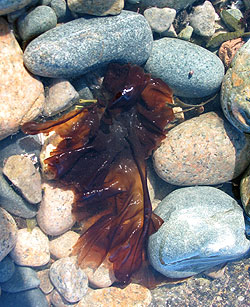
P. umbilicalis photo courtesy Nicolas Blouin, Univ. of Maine.
Porphyra species are among the most common algae in the intertidal and subtidal zones of temperate rocky shores in both the northern and southern hemispheres. Porphyra umbilicalis is a marine red alga. The red algae occupy a pivotal position in eukaryotic evolution as a sister group to green algae/plants. Porphyra species are particularly notable for having a sexual life history with two adult phases that have different traits (e.g., different cell wall composition, morphology, ultrastructure). This alga is also an important human food (“laver”, “nori”).
The Porphyra genome will likely be important for analyses of nuclear-organelle co-evolution (e.g., understanding gene transfers between the chloroplast and nucleus and the import of proteins into the chloroplast), studies of nitrogen and carbon metabolism in photosynthetic organisms, comparative investigations of how multicellular complexity arose independently in different eukaryotic groups, and as the source of new markers for studies in molecular evolution and systematics. Our understanding of the effects of elevated global stresses on photosynthetic organisms would benefit from genome-enabled studies of carbon fixation in Porphyra, because this alga has a great diversity of light-harvesting and photo-protective strategies.
Porphyra umbilicalis is one of several closely related Atlantic species (P. purpurea, P. umbilicalis, and P. linearis) that are under development as mariculture crops, and there is particular interest in achieving understanding and control over asexual reproduction. Analyses of the genome sequence and development of gene models for Porphyra umbilicalis should accelerate an understanding of what triggers sexual versus asexual reproduction in eukaryotes, and may provide information on asexual spore differentiation that will allow cost-effective net-seeding of Porphyra for bioremediation of finfish aquaculture in U.S. coastal waters. Integrated mariculture that combines finfish with sea vegetables (i.e., Porphyra, kelps, etc.) and/or shellfish will prevent eutrophication (overgrowth caused by nutrient pollution) of coastal waters because the algae take up nitrogen and phosphorus that are released in fish excretions.
Principal Investigator: Susan H. Brawley (Univ. of Maine)